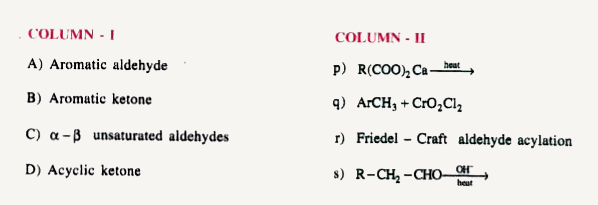Ethyl cyanide is reduced with SnCl2 and HCI, compound (A) is formed, which on hydrolysis gives product (B). The no. of pure orbitals present in the compound(B) Solution in Telugu
The correct Answer is:8
CH3−CH2−CNSaCI2−−−→HCIC2H5−CH2−NH2H2O−−→CH3−CH2−CH2−CH2−OH+NH3
No. Of pure orbitals =8 ( in H- atoms )
Topper's Solved these Questions
- BOOK - AAKASH SERIESCHAPTER - ALDEHYDES AND KETONESEXERCISE - PRACTICE SHEET-130videos
ALDEHYDES AND KETONES
- BOOK - AAKASH SERIESCHAPTER - ALDEHYDES AND KETONESEXERCISE - PRACTICE SHEET-230videos
ALDEHYDES AND KETONES
- BOOK - AAKASH SERIESCHAPTER - ALDEHYDES AND KETONESEXERCISE - LEVEL-II LECTURE SHEET (EXERCISE-IV)8videos
ALDEHYDES AND KETONES
- BOOK - AAKASH SERIESCHAPTER - ALCOHOLS, PHENOLS AND ETHERSEXERCISE - ETHERS (OBJECTIVE EXERCISE-4)50videos
ALCOHOLS, PHENOLS AND ETHERS
- BOOK - AAKASH SERIESCHAPTER - ALKYL AND ARYL HALIDESEXERCISE - OBJECTIVE EXERCISE - 4 (ASSERTION (A) & REASON (R) TYPE QUESTIONS)19videos
ALKYL AND ARYL HALIDES
Similar Questions
cyclohexene CI2/hv−−−−−−−−−−−→Monoha logenetion AalcKOH−−−−→B(1)O3−−−−−−−→(2)Zn/H2O products . The final product in the reaction sequence above
View SolutionCH3−C≡CHDil.H2SO4−−−−−−→Hg+A,ACHCI3−−−→BAI2NaOH−−−−→C respectively in the above sequence is
04:04View SolutionComplete the following reaction
 05:41View Solution
05:41View Solution(A): Alcoholic fermentation involves conversion of sugar into ethanol by the action of yeast.
(R): Fermentation involves the liberation of CO2 gas.04:04View Solution(A) Towards SN2 reaction, order of reactivity is CH3Br>CH3CH2Br>(CH3)2CHBr>(CH3)3CBr.
(R) Greater the stability of carbocation, greater will be its ease of formation from alkyl halide and faster will be the rate of SN1 reaction.View SolutionAn organic compound A reacts with methyl magensium iodide to form an addition product which on hydrolysis forms the compound B. Compound B give blue colour salt in Victor Meyer's test. The compounds A and B are respectively.
View SolutionMethyl cyanide reacts with ethyl magnesium Bromide and forms an addition compound which on hydrolysis forms a compound (A). The functional Isomer of (A) is
06:42View SolutionAn organic compound (A) reacts with methyl magnesium iodide to form an addition product which on hydrolysis forms the compound (B). Compound (B) gives blue colour salt in Victor Meyer's test.The compounds (A) and (B) are respectively :
02:35View Solutionp-cresol reacts with chloroform in alkaline medium to give the compound A which adds hydrogen cyanide to form, the compound B. the latter on acidic hydrolysis gives chiral caboxylic acid. The structure of the carboxylic acid is
View SolutionA nitraite on acid hydrolysis gives compound A, which reacts with thionyl chloride to give compound B. Benzene reacts with compound B in presence of anhydrous AlCl3 to give compound C. The compound B reacts with ethyl alcohol to give ester D. Identify the compounds A,B C and D and write the equations.
05:20View SolutionThe compounds formed by the acid by the acid hydrolysis of ethyl acetate are
05:41View SolutionCompound A which treated with ethyl magnesium iodide in dry ether forms an addition compound which on hydrolysis forms compounds B.The compound B on oxidation forms 3-pentanone.Hence the compound A and B are :
View SolutionHydrolysis of ethyl cyanide gives :
01:27View Solutionp-cresol reacts with chloroform in alkaline medium to give the compound A which adds hydrogen cyanide to form, the 29. compound B. The latter on acidic hydrolysis gives chiral carboxylic acid. The structure of the carboxylic acid is
03:14View SolutionBenzonitirle (A) reacts with stannous chloride in the presence of dil HCl to give a reduction product 'B' . Compound 'B' on acid hydrolysis gives compound 'C' . Identify compound 'B' and 'C' . What is the nitration product of compound 'C' ?
02:32View Solution

